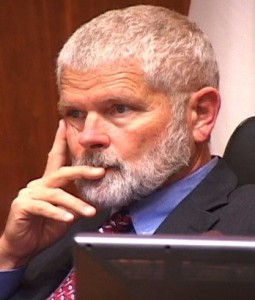State employee demoted after crossing Gibson
September 26, 2015

Supervisor Bruce Gibson
By JOSH FRIEDMAN
Succumbing to pressure from San Luis Obispo County Supervisor Bruce Gibson, the California Geological Survey has demoted a state geologist who is critical of the science behind a contested local air pollution regulation. The demotion has prompted feuding among county officials.
In June, a senior engineering geologist, spoke during public comment at an Air Pollution Control District (APCD) board meeting in which he argued the district’s Oceano Dunes dust rule is pointless. During the meeting, County Supervisor Adam Hill threatened the geologist’s job. Three days later, Gibson followed up the threat in a letter to California’s chief geologist.
Now, the geologist has lost his office and is working in a school safety position. He was moved to an office on a lower floor of his work building.
In a farewell letter to colleagues who worked with him on off-road vehicle parks, The geologist wrote the Geological Survey removed him from the position because of his comments at the June San Luis Obispo County APCD meeting.
In the letter, the geologist said that Gibson complained to his bosses.
Don Drysdale, an information officer with the Department of Conservation, confirmed with CalCoastNews that Gibson contacted chief geologist John Parrish about the geologist. Drysdale said the conservation department does not consider the employee’s change in role to be a demotion. Rather, it is a reassignment, Drysdale said.
The APCD dust rule is based on a contested study that concluded off-road activity on the dunes has caused an increase in pollution on the Nipomo Mesa. The rule requires state parks to reduce the amount of particulate matter blowing from the off-road vehicle area to natural background levels or face fines of $1,000 per day.
At the June meeting, the geologist said natural background levels of dust are actually higher than the current levels because state parks has planted vegetation in the area.
The geologist has since distributed aerial images comparing the dunes in the 1930s to the dunes in 2014. The 1930s image displays more sand than the 2014 picture, and the recent image shows that much of what used to be open sand is now covered with vegetation.
One of the areas with considerable vegetation is the location the APCD selected as its control for air quality readings. To test whether the dust blowing from the off-road area of the dunes is exceeding “natural background levels,” the APCD set up a monitoring station downwind of the riding area and a monitoring site downwind of a control location that is further south and is not used for off-roading.
The APCD could levy fines against state parks on days in which there is more pollution at the location downwind of the riding area than at the control site. The APCD is currently facing an approximately $300,000 funding shortfall because of lost fees from the shutdown of the Morro Bay power plant.
In a memo to state parks, the geologist wrote the APCD set up the monitoring sites in a way that skews the results so that more violations of the dust rule occur. For instance, the control site is an area with more vegetation and less wind.
On Wednesday, the APCD board met for the first time since June. During the meeting, Gibson and Hill chastised other board members who defended the geologist and questioned the science of the dust rule.
During approval of the minutes, County Supervisor Debbie Arnold made a motion calling for the minutes of the June meeting to state that Harris was interrupted during his public comment.
.
San Luis Obispo Mayor Jan Marx, an ally of Hill and Gibson, said Arnold was making things up and her motion was “creative writing.” Gibson said it was “contrary to reality.”
Hill responded by saying the board could say anything in the minutes.
“We can say a dolphin walked down the aisle,” Hill said.
Paso Robles Councilman John Hamon, who is currently running for District 1 county supervisor, said he was embarrassed by how fellow board members handled the exchange with the geologist at the June meeting.
Ultimately, the board voted 6-5 in support of Arnold’s motion.
.
A short time later, Supervisor Lynn Compton also questioned the science behind the dust rule. Compton asked why the APCD is comparing air samplings from a location that is a sheet of sand to a control location that is heavily vegetated.
“It’s hard for me to understand that this is an equal comparison,” Compton said. “You’re not comparing apples to apples.”
Gibson responded by saying the best technical minds of the APCD, state parks and state Air Resources Board agreed on the control site. He then called Compton close-minded.
Referring to the geologist, Compton said a scientist testified that the monitoring sites were not an equal comparison. Gibson responded by saying Harris’s “technical credibility is pretty well shot.”
The APCD website lists five engineers who work on local air quality monitoring issues. Of those, none are licensed professional engineers, according to the California Department of Consumer Affairs.
Will the geologist’s memo outlining his concerns about the dust rule:
Email.OceanoDunes by CalCoastNews
Get links to breaking news stories, like CCN on Facebook.






The comments below represent the opinion of the writer and do not represent the views or policies of CalCoastNews.com. Please address the Policies, events and arguments, not the person. Constructive debate is good; mockery, taunting, and name calling is not. Comment Guidelines